5 Stinging Nettle Look-Alikes
Did you find what you believe to be stinging nettles and want to ensure you identify them correctly? Here’s how to recognize stinging nettles and a list of their most common look-alikes.
Stinging nettle (Urtica dioica) is a perennial plant native to Europe, parts of Asia, and western North Africa, but is now found worldwide. It belongs to the genus Urtica, the family Urticaceae. Some of its other common names include “common nettle” or “burn nettle.”
This species is divided into 6 subspecies:
- U. dioica subsp. dioica
- U. dioica subsp. galeopsifolia
- U. dioica subsp. gracilis
- U. dioica subsp. gansuensis
- U. dioica subsp. holosericea
- U. dioica subsp. afghanica
Five of these subspecies carry stinging hairs (trichomes) on the stems and leaves and inject a compound called “histamine.” This can produce irritation or a burning sensation upon contact with the skin.
The leaves of young stinging nettle plants are edible. They are cooked in many recipes, but can also be consumed raw in salads after the leaves are soaked and rubbed together to get rid of the stinging hairs.
This plant was not only a food source but has also been used in traditional medicine, cosmetics, the textile industry, and other fields for centuries.
What do stinging nettles look like?
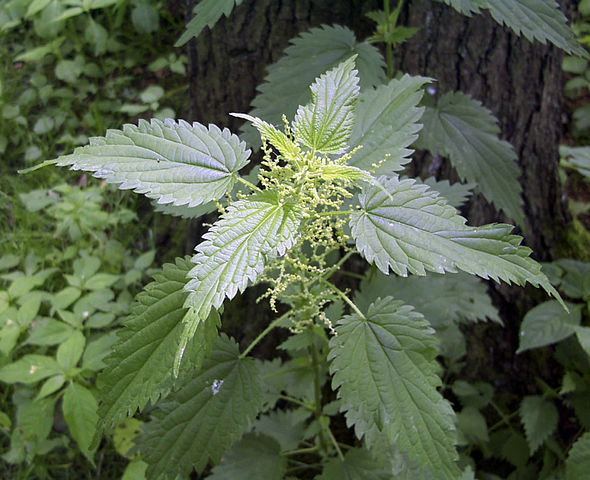
Before listing some of the stinging nettle look-alikes, we first need to know how to identify this plant properly.
Stinging nettle grows upright and usually reaches 3-7 ft (1-2 m) tall.
The leaves are green, soft, 1-6 in (3-15 cm) long, and grow oppositely on the stem. They have strongly serrated margins, a heart-shaped base, and end with a long terminal tooth.
Depending on the subspecies, the leaves and stems carry stinging or non-stinging hairs. On the stinging species, when touched, these hairs act like needles and inject several chemicals, causing a burning sensation and irritation.
The stinging nettles spread via creeping rhizomes and seeds and usually form dense colonies. Not many species of herbivores can consume these plants in their living state due to the stinging they provoke.
Urtica dioica produces tiny clusters of many greenish or white flowers on the leaf axils and stems tips during the blooming period.
The stinging nettle has several look-alikes and can be easily mistaken with these. Below is a list of several plants that look like stinging nettles, but are not.
Contents
1. White Dead Nettle (Lamium Album)
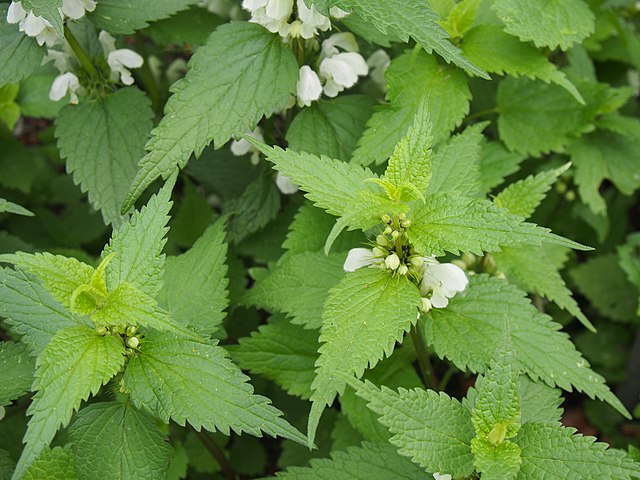
White dead-nettle (Lamium album) is a perennial plant in the family Lamiaceae, native to Europe and Asia. It is also commonly known as white nettle or white henbit.
This plant looks very similar to stinging nettle, but unlike Urtica dioica, Lamium album does not sting, hence its common name, “dead nettle.”
The white dead nettle grows upright and usually doesn’t exceeds 39 in (100 cm) in height. The stems are rectangular with leaves growing opposite along it from nodes.
The leaves of white dead nettle resemble the look of the leaves of stinging nettle, but they lack the stinging hairs. They are green, have a triangular shape with a rounded base, serrated margins, and are softly haired.
Lamium album produces white individual flowers in whorls on the upper part of the stem.
White dead nettle can grow in a variety of habitats but thrives especially in moist, fertile soils. It is frequently found in open grasslands, woodland edges, and disturbed grounds.
The young leaves of this plant are edible and can be consumed both cooked or in salads.
2. Dwarf Nettle (Urtica Urens)
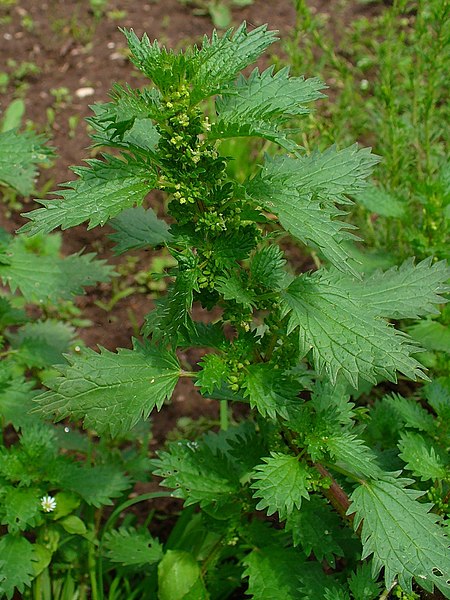
Dwarf nettle (Urtica urens) is an annual plant in the family Urticaceae. It is native to Europe and Asia and introduced to many other regions. Some of its other common names include annual nettle, dog nettle, lesser nettle, small nettle, bush stinging nettle, or burning nettle.
It looks pretty similar to stinging nettle and can easily be mistaken for it. Fortunately, the dwarf nettle is also considered edible, and there’s no risk of poisoning if you confuse these two species.
The first element that differentiates these two species is that Urtica urens grows much shorter than Urtica dioica. It usually doesn’t exceed 30 inches (76 cm) in height.
Other features that can help you distinguish the dwarf nettle from the stinging nettle are its more elliptical leaves with coarser, deeper toothing. Also, the leaf terminal tooth of Urtica urens is about the same size as the other marginal teeth.
The leaves are green, have an elliptic to round shape, with a wedge-shaped–blunt base, are greatly serrated, present dispersed stinging hairs on both sides, and grow oppositely on the stem.
The stems are 4-edged, grow upright, can be simple or branched (often branched), and carry stinging hairs.
The dwarf nettle blooming period is July to September and produces small spike-like inflorescences.
It grows in many conditions including gardens, arable lands, stream banks, grassland, disturbed soils, etc.
3. Canadian Wood Nettle (Laportea Canadensis)

Canadian wood nettle or wood-nettle (Laportea Canadensis) is a perennial plant in the nettle family, Urticaceae. It is native to eastern and central North America.
Laportea Canadensis grows upright and usually doesn’t exceed 47 inches (1.2m) in height. It typically forms dense clumps of plants in the proper environmental conditions.
The stem is cylindrical, unbranched, and has many stinging hairs on its surface.
The leaves are simple, dark green, oval to egg-shaped, with coarsely serrated margins, long stalk, and pointed tip. The surface of the young leaves is covered in thin stinging hairs while the older leaves tend to have more hairs on the underside.
Unlike the stinging nettle where the leaves grow oppositely on the stem, the leaves of Laportea canadensis grow alternately.
From July to August, Laportea canadensis produces clusters of tiny, greenish flowers in the leaf axils.
Canadian wood nettle’s young shoots and leaves are edible and taste like spinach when cooked.
The wood nettle prefers moist soils with partial to deep shade. It frequently grows along streams, moist bottomlands, or in open woods.
4. Clearweed (Pilea Pumila)
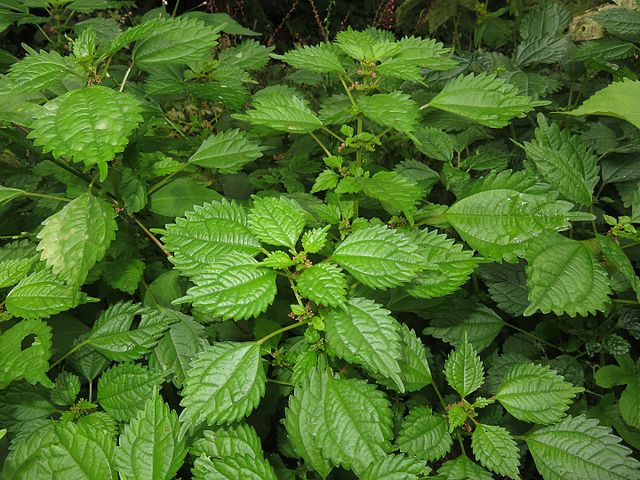
Clearweed (Pilea pumila) is an annual plant in the Urticaceae family. It is native to eastern North America and Asia.
Pilea pumila can reach a height of about 28 inches (70 cm) tall when the plant flourishes. It forms dense colonies and is often found growing in forests or wet areas with rich loamy soil.
Clearweed is frequently mistaken for stinging nettle. However, several characteristics can help you distinguish them easily.
The leaves are bright green, shiny, wrinkly, ovate, have serrated margins, and attach to the stems via long petioles.
Although its leaf shape may look similar to the one of stinging nettle, one of the fundamental differences between these two plants is the lack of stinging hairs on the surface of clearweed’s leaves.
The stem is translucent, smooth, lacks hairs, and the leaves grow oppositely on it.
The blooming period of Pilea pumila extends from mid-summer to early fall. The plant produces clusters of tiny greenish-yellow flowers.
The young foliage of clearweed is edible.
5. False Nettle (Boehmeria Cylindrica)
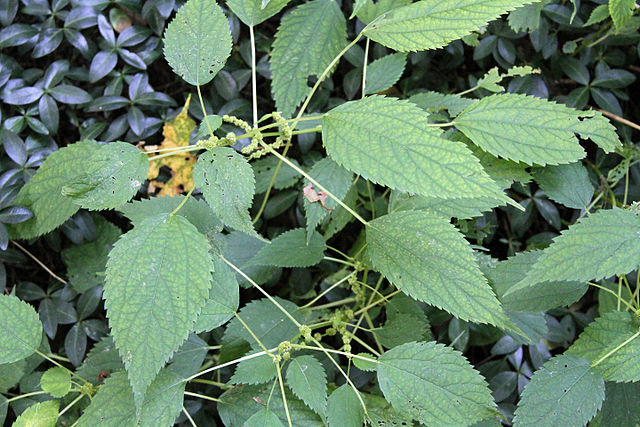
False nettle (Boehmeria cylindrica) is a perennial plant in the Urticaceae family. It is native to Canada and North America. It is also commonly called “bog hemp.”
Boehmeria cylindrica typically doesn’t grow more than 63 inches (160 cm) in height and is usually found in wet places like bogs, swamps, wet meadows and ditches.
The false nettle may look alike to stinging nettle, but does not have any stinging hairs.
The stem is smooth and can be simple or branched.
Its leaves are green, hairless, have a broadly oval shape with a rounded base, a sharp tip, and a long petiole. The leaf edges are coarsely toothed.
The inflorescences are spikes of green or greenish white tiny flowers and develop from the axils of the superior leaves. Its blooming season extends from summer to fall.
Although false nettle is less common than other species of nettles, it is considered edible.
Final Word
Stinging nettle is a common plant found in many regions of the world. Altough many hate them for their stinging hairs that cause skin irritation, these plants have been a valuable food source for ages.
It may be challenging to identify stinging nettles sometimes as there are many other species of plants in the nettle family that look pretty similar to them.
Fortunately, there are no known poisonous look alikes to stinging nettles.
In this article we have presented several plants that are commonly confused with stinging nettles. Hopefuly the next time you stumble upon this species of nettle or one of its look-alikes, you should be able to accurately identify it.

